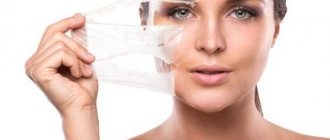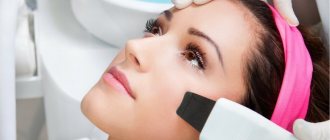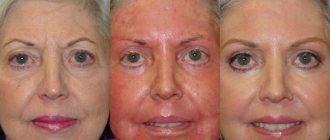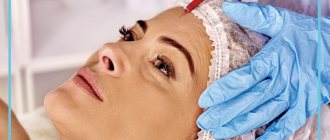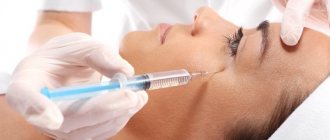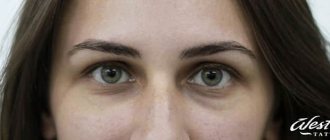In order to see your face looking young and radiant after peeling, you must adhere to certain skin care rules. As a rule, a cosmetologist gives a list of advice to a woman after the exfoliation procedure. These requirements are mandatory.
Some women believe that by choosing an experienced cosmetologist and paying a considerable amount for exfoliation, they are guaranteed to get a good result. Of course, the success of the procedure depends on the professionalism of the salon master. But the result is greatly influenced by how correctly the rehabilitation was carried out. Even the impeccable work of a cosmetologist can be nullified by incorrect post-peeling care.
When is it necessary to take care of your facial skin?
Daily skin care should be practiced throughout your life, starting at age 16.
But different facial skin care products should be used. Selection criteria are skin type and age. All cosmetics must be applied along massage lines. Violation of this rule will lead to stretching of the skin and early wrinkles.
Minimum 3 stages
There is a mandatory minimum home program, consisting of 3 stages, which should be performed daily, morning and evening.
Cleansing
- Skin cleansing. In the morning, the skin needs to be cleansed to remove traces of the night activity of skin cells, otherwise they may be absorbed back when applying the cream. Evening cleansing removes dirt and makeup. After washing, the skin should be lightly blotted with a towel; do not rub.
To avoid transepidermal loss of moisture and, as a result, dryness and tightness of the skin, you need to use “washes” that do not contain sodium sulfate.
Mechanical facial cleansing: the cost at Crystal cosmetology will be 500 rubles (makeup remover, cleaning, tonic, final cream), with a skincare procedure - 800 rubles (makeup remover, peeling, mechanical cleansing, darsonval, tonic, mask, final cream). + ultrasonic cleaning - 1000 rubles.
Toning
- Skin toning. You should wipe your face with toner after each cleansing to normalize the pH of the skin and also prepare it for the subsequent application of moisturizer. For those with all skin types (including those caring for oily skin), it is preferable to use an alcohol-free toner. For problem skin with acne, a toner with AHA acids is ideal.
Hydration
- Skin moisturizing. A must-have step even when caring for oily skin! Lack of moisture in the epidermis is the path to early skin aging.
It is recommended to apply day cream at least 30 minutes before going outside. The optimal time to apply night cream is 1-2 hours before going to bed: the facial care product is effective only when the muscles are mobile. Girls under 25 years old do not need to use night cream, as young skin repairs itself. Evening care can be reduced to cleansing and toning. In addition, in order for the skin to remain smooth and fresh, it is necessary to periodically free it from dead cells. To do this, you can scrub your face 2 times a week. Owners of problem skin with acne should not perform deep cleansing, and if the skin is overly dry, sensitive, you can use the scrub less often - a couple of times a month.
What should you not do after peeling?
There are certain recommendations from cosmetologists about what not to do after facial peeling:
- You should not wash your face with water for the first 24 hours after exfoliation. After 2-3 days, you can wash your face with boiled warm water. After a few days, it is recommended to use mild cleansers that do not contain abrasive particles;
- The use of cosmetics and decorative cosmetics is also not allowed. Foundation, powder, blush, bronzer or highlighter can become a source of infection and clog pores. In addition, makeup applied to flaky skin looks unaesthetic;
- visiting a bathhouse, experiencing stress, eating spicy foods, and drinking alcoholic beverages is not recommended. All these actions lead to dilation of blood vessels and prolong the period of hyperemia (redness of the face);
- Do not engage in active sports, as this promotes increased sweating. Drops of sweat contain salts and irritate the epidermis, and are also a favorable environment for the development of infection;
- Trying new brands of cosmetics is not recommended, as the skin's reaction to them can be unpredictable. The cosmetologist will tell you what products and preparations need to be used after superficial or other peeling;
- Do not self-medicate if complications or adverse reactions occur. In this case, you need to contact a cosmetologist or dermatologist;
- Do not expose your skin to the risk of infection: touch it with your hands, visit the pool, swim in natural bodies of water;
- stay in direct sunlight for a long time, walk in windy, rainy or frosty weather.
What types of skin care treatments are there?
“How to properly care for your facial skin,” millions of women are interested in. We answer: it is ideal when competent home skin care is combined with regular visits to a cosmetologist. During skincare procedures, the doctor, depending on the age and skin type of the client, selects a program that allows solving a specific problem. Most skin care procedures include: cleansing the skin, light peeling, toning, facial massage (classical, plastic, Jacquet or lymphatic drainage), application of an active concentrate, then a mask. Also, skincare procedures are often performed according to a more accelerated program: peeling, facial massage and, of course, applying a mask - cream, alginate, collagen or Matrigel.
In addition, the price list of many salons separately includes facial massage, which is recommended to be carried out in a course of 10-15 sessions. This massage improves blood microcirculation, strengthens the muscular frame of the face, providing a lifting effect. To enhance the result, concentrates are usually applied under the massage cream. When caring for the face after 40 to reduce wrinkles, a more noticeable effect, of course, will be from hardware or injection methods.
After skincare procedures, a cosmetologist, having diagnosed the skin, can select facial skin care products at home. The effect of properly selected professional cosmetics for facial skin care will be many times higher than from using self-selected mass market products.
In addition to various facial procedures, the price list of salons also usually includes care programs for the skin of the eyelids, neck and décolleté.
Medium skin peeling
Medium peels are used for skin rejuvenation, because... actively stimulate the production of collagen in the dermis, as well as to combat hyperpigmentation.
Among the most popular: Jessner peel and its modifications, TCA (trichloroacetic peels), retinol/retinoic (also called “yellow peel”).
Medium peeling affects the entire stratum corneum and part of the epidermis. The most likely post-peeling consequences : the occurrence of erythema, the skin will peel, and during the procedure the occurrence of unpleasant sensations in the form of a burning sensation, sometimes accompanied by swelling. All this is normal , and usually the degree of manifestation depends on the number of layers that are applied during the procedure and how deeply the skin is affected!
Sometimes the post-peeling period is accompanied by pustular rashes, which indicates improper preparation of the skin.
Medium peeling is excluded for skin with hypersensitivity.
Healing takes 7 days, during which noticeable peeling, redness and some swelling of the skin are noted. This type of peeling procedure requires the strictest adherence to post-peel care instructions:
Cleanser
If skin barriers are damaged, the cleanser should not foam and contain aggressive surfactants. Only special preparations for delicate and sensitive skin are recommended, in the form of milk, with an oil base.
Example : DermaQuest Cleansing Milk for Delicate Skin is a cleansing milk based on valuable Shea and Jojoba oils with a cream texture. Removes all impurities while restoring damaged barriers of delicate and sensitive skin. Instantly gives skin softness and comfort.
To remove impurities, it is recommended to apply to dry or slightly damp skin, gently massage and remove with a damp cloth.
Protective cream with SPF30
To avoid possible and frequent complications in the form of dark age spots, creams containing physical factors that protect the skin (photo filters) from sunlight are regularly used.
These products are recommended to be used throughout the entire post-peeling period from the moment peeling appears until the integrity of the epidermis is completely restored, regardless of: time of year, sensitivity to the sun/ultraviolet.
Particles of physical (mineral SPF) mechanically protect the skin from rays and remain on the skin throughout the day.
Oil-based serums and creams
They are used to maintain the elasticity of the film formed on the face after peeling and to prevent it from cracking during the first days after the procedure. Maintains a crust, which retains moisture in the tissues to improve regeneration.
Healing and restorative products
When peeling occurs, it is necessary to include in your care products: with a healing effect (based on panthenol and royal jelly) and a restorative effect. Prescribe 2-4 applications per day or as needed to eliminate the feeling of skin tightness.
Lightening agents
Prescribed when working with pigmentation, or if there is a tendency to form it, in order to inhibit the hyperproduction of melanin in response to skin trauma.
It is important to strictly select the product, carefully studying its composition! The drug should not have an irritating or aggressive effect on the skin. Excluded: acids, retinol and hydroquinone .
Indications for care procedures
Since skincare procedures are individually selected, they can solve almost all skin problems, including facial care after 40 years. Main indications:
- problematic skin with rashes, enlarged pores, increased oiliness
- rosacea
- dry, dehydrated skin
- presence of age-related changes (fuzzy oval face, loss of skin elasticity)
- swelling of the face and eyelids
- the need to restore skin after surgical interventions
- prevention of aging
- hyperpigmentation.
upcoming special event (most salons offer express programs for radiant, fresh skin)
Types and features of chemical peels
Chemical facial peeling procedures vary in the extent to which they affect the skin. The deeper it is, the more noticeable changes can be achieved. There are the following levels of exfoliation:
Surface cleaning.
The drug affects only the superficial layers of the epidermis, which contain no living cells. Such procedures are common, as they provide an opportunity to refresh the skin without pain and long recovery. If you have some experience, you can perform a chemical glycolic facial peel at home.
The superficial effect of acids helps eliminate hyperkeratosis, cleanse the sebaceous glands, and reduce acne. It helps to even out skin color and texture. This type of procedure is suitable for teenagers suffering from acne and increased oily skin. Can be used by people aged 25–30 years to combat initial age-related changes.
Medium chemical facial peeling.
The peeling agent penetrates the basal, spinous and granular layers of the epidermis, where viable cells are present. The papillary layer of the dermis is also affected. The manipulation may be accompanied by moderate discomfort, but no significant pain occurs.
Mid-level exfoliation is popular among people over 30 years of age. It allows you to tighten and smooth the skin, improve microcirculation, and restore the level of collagen and elastin production. Since acid chemical peeling of the face of this level affects quite deep structures, it is not recommended to carry out the procedure at home. If the cleaning technique is violated, post-peeling scars and hyperpigmentation zones are formed.
Deep chemical peeling.
Quite a serious manipulation, which is at the intersection of cosmetology and aesthetic medicine. Under the influence of the acidic composition, the skin is destroyed up to the middle of the mesh layer. The procedure is carried out only in a clinical setting with subsequent inpatient observation for 2–3 days. High-quality pain relief is required.
Deep peelings allow you to renew the collagen-elastin framework and stimulate the production of natural regenerative factors. With the help of such an effect, it is possible to eliminate shallow scars and scars, post-acne. Exfoliation is indicated for people over 45–60 years of age or people with significant cosmetic skin defects. Such deep cleaning is not carried out at home.
Contraindications for facial skin care
Since care programs are usually selected individually (after consultation), it is difficult to identify common contraindications. Most manufacturers offer “designer” facial skin care products that can be combined with each other to create a program that is suitable specifically for this client.
Alginate masks, the most popular salon procedure, have virtually no contraindications (only individual intolerance to the components). There are more restrictions when doing facial massage:
- violation of the integrity of the skin, its inflammation, including acute dermatoses
- active stage of herpes
- infectious diseases
- bleeding
- diseases of the trigeminal nerve, circulatory system
malignant neoplasms.
When doing facial massage according to Jacquet (it is often used for problem skin with acne), pronounced rosacea is added to this list.
Effectiveness of facial skin care
Many clients believe that home care using professional cosmetics can replace care treatments in the salon. It is a mistake to think so. Each manufacturer's assortment includes facial care products intended for salon and home use. Professional preparations have a higher concentration of active substances, but using them without special training is difficult and sometimes dangerous. In addition, since care programs are developed individually, using facial skin care cosmetics that complement each other, the effect cannot be compared with the consequences of self-medication!
Another common misconception: skincare procedures are less effective than hardware and injection techniques. Since the mechanisms of action are different, there is no point in comparing these techniques. The result depends on the desired effect. For example, to improve the condition of the upper layers of the skin, treatments using high-quality facial care products can provide better results than other techniques. Often, to achieve the best effect, a cosmetologist combines hardware, skincare and injection techniques.
Therefore, to the question “How to care for your facial skin?” the answer is always different. The transformation program is individual for each patient. Some girls are better suited for skin care treatments using high-quality facial skin care products, while others prefer a combination of several techniques. The main thing is to quickly achieve your goal, namely, a professional with a medical education will recommend optimal care for oily skin, facial care after 40, etc.

